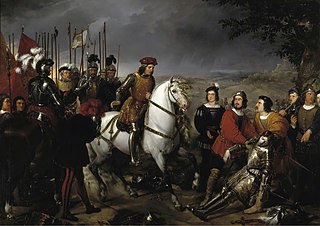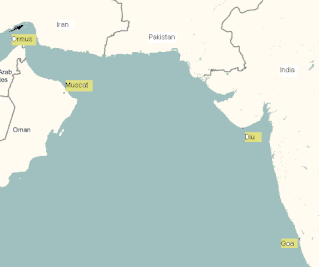Events from the year 1504 in India.
| |||||
| Centuries: | |||||
|---|---|---|---|---|---|
| Decades: | |||||
| See also: | List of years in India Timeline of Indian history | ||||
Events from the year 1504 in India.
| |||||
| Centuries: | |||||
|---|---|---|---|---|---|
| Decades: | |||||
| See also: | List of years in India Timeline of Indian history | ||||

The 15th century was the century which spans the Julian dates from 1 January 1401 to 31 December 1500 (MD).

The 16th century began with the Julian year 1501 and ended with either the Julian or the Gregorian year 1600 (MDC), depending on the reckoning used.

Year 1504 (MDIV) was a leap year starting on Monday of the Julian calendar.

Guru Angad was the second of the ten Sikh gurus of Sikhism. After meeting Guru Nanak, the founder of Sikhism, becoming a Sikh, and serving and working with Nanak for many years, Nanak gave Lehna the name Angad, and chose Angad as the second Sikh Guru.

The Battle of Diu was a naval battle fought on 3 February 1509 in the Arabian Sea, in the port of Diu, India, between the Portuguese Empire and a joint fleet of the Sultan of Gujarat, the Mamlûk Burji Sultanate of Egypt, and the Zamorin of Calicut with support of the Republic of Venice and the Ottoman Empire.

The Deccan sultanates were five late-medieval Indian kingdoms—on the Deccan Plateau between the Krishna River and the Vindhya Range—that were ruled by Muslim dynasties: namely Ahmadnagar, Berar, Bidar, Bijapur, and Golconda. The sultanates had become independent during the break-up of the Bahmani Sultanate. The five sultanates owed their existence to the declaration of independence of Ahmadnagar in 1490, followed by Bijapur and Berar in the same year. Golconda became independent in 1518, and Bidar in 1528.

The Lodi dynasty was a dynasty that ruled the Delhi Sultanate from 1451 to 1526. It was the fifth and final dynasty of the Delhi Sultanate, and was founded by Bahlul Khan Lodi when he replaced the Sayyid dynasty.

The Cheraman Juma Mosque is a mosque in Methala, Kodungallur, Thrissur in the Indian state of Kerala. A legend claims that it was built in 643 CE, which makes it the oldest mosque in the Indian subcontinent which is still in use. It was built on the orders of the successor of Cheraman Perumal, the Chera King of modern-day Kerala. The mosque was constructed in Kerala style with hanging lamps, making the historicity of its date claims more convincing. However, other scholars are more skeptical and dated the structure to the 14th-15th century based on the architectural style.
Berar Sultanate, also called as Imad Shahi Sultanate was one of the Deccan sultanates, which was founded by an Indian Muslim. It was established in 1490 following the disintegration of the Bahmani Sultanate.

The Gujarat Sultanate, or the Sultanate of Guzerat, was a late medieval Indian kingdom established in the early 15th century in Western India, primarily in the present-day state of Gujarat, India. The kingdom was founded by Muzaffar Shah I who was appointed as Tughlaq governor of Gujarat after the death of his father in 1371. Following Timur's invasion of the Delhi Sultanate, Delhi was devastated and its rule weakened considerably, so he declared himself independent in 1394, and formally established the Sultanate. The next sultan, his grandson Ahmad Shah I moved the capital to Ahmedabad in 1411. His successor Muhammad Shah II subdued most Rajput chieftains. The prosperity of the sultanate reached its zenith during the rule of Mahmud Begada. He also subdued most Gujarati Rajput chieftains and built a navy off the coast of Diu. In 1509, the Portuguese empire wrested Diu from the Sultanate in the Battle of Diu (1509). The Mughal emperor Humayun attacked Gujarat in 1535 and briefly occupied it, during which Bombay, Bassein & Daman would become a Portuguese colony, thereafter Bahadur Shah was killed by the Portuguese while making a deal in 1537. The end of the sultanate came in 1573, when Akbar annexed Sultanate of Guzerat into his empire. The last ruler Muzaffar Shah III was taken a prisoner to Agra. In 1583, he escaped from the prison and with the help of the nobles succeeded to regain the throne for a short period before being defeated by Akbar's minister Abdul Rahim Khan-i-Khanan.

The Battle of Raichur was a battle fought between the Vijayanagara Empire and the Sultanate of Bijapur in 1520 in the town of Raichur, India. It resulted in a decisive victory for Vijayanagara forces, and the Bijapur ruler was defeated and pushed across the river Krishna.
The Sixth India Armada was assembled in 1504 on the order of King Manuel I of Portugal and placed under the command of Lopo Soares de Albergaria.

Egyptian Mamluk–Portuguese conflicts refers to the armed engagements between the Egyptian state of the Mamluks and the Portuguese in the Indian Ocean, following the expansion of the Portuguese after sailing around the Cape of Good Hope in 1498. The conflict took place during the early part of the 16th century, from 1505 to the fall of the Mamluk Sultanate in 1517.

Events from the year 1534 in India.
Events from the year 1552 in India.
Events from the year 1535 in India.
Events from the year 1536 in India.
Events in the year 1661 in India.
This is a timeline of the 17th century.